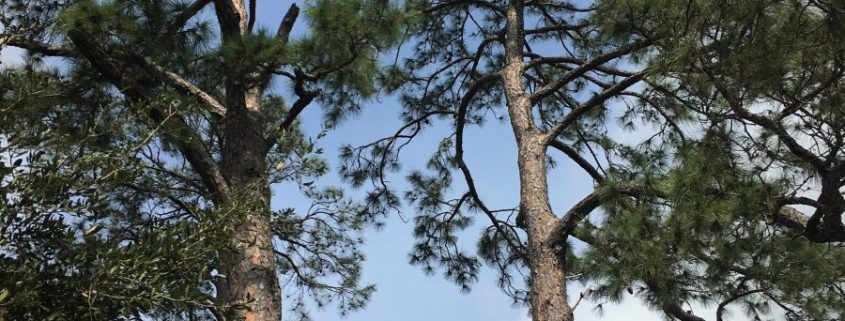Mid-January at Alabama’s Gulf State Park: Interior Forests and Prescribed Fire
Because this is the third of four GBH Blog Posts from my visit to Gulf State Park, allow me to repeat elements of my introduction:
Introduction
I toured Gulf State Park (GSP) January 18, 2019 from 8-5:30 with Kelly Reetz, Park Naturalist. See my January 28, 2019 Great Blue Heron Blog Post for my Overview: https://stevejonesgbh.com/2019/01/28/mid-january-at-alabamas-gulf-state-park-overview/ and my February 5, 2019 Post on the beach, dunes, savannas, and wetlands ecotypes: https://stevejonesgbh.com/2019/02/05/mid-january-at-alabamas-gulf-state-park-beach-dunes-savannas-and-interior-wetlands/
The 2016 Gulf State Park Master Plan identified nine distinct GSP ecosystems:
- Evergreen Forests
- Pine Savannas
- Maritime Forests
- Dune Ridges / Sand Scrub habitats
- Fresh and Salt Marshes
- Freshwater and Brackish Lakes
- Coastal Swales
- Dunes
- The Beach and Gulf
I promised three subsequent Gulf State Park GBH Posts:
- Beach, Dunes, Savannas, and Interior Wetlands (Last week’s)
- Interior Forests and Prescribed Fire (This one)
- Oh Beautiful for Spacious Skies (Coming soon)
I described the first GSP Post as a broad “Overview of a Globally Significant Coastal Center for Sustainable Tourism and Earth Stewardship.” I issued my second GSP Post February 5, highlighting the beach, dune, savanna, and interior wetland ecotypes, offered “from my perspective as a doctoral level applied ecologist, lifelong Nature enthusiast, environmental educator, consummate champion for responsible Earth stewardship, and a tireless advocate for Nature-inspired life and living.” From that same perspective, I will now reflect with photographs and text on my impressions and interpretation for a second set of ecosystems: evergreen forests and xeric forests. I’ve included a section on the use of prescribed fire in Park vegetation management.
Evergreen Forests
Longleaf pine (Pinus palustris) is the quintessential southern pine. When European settlers arrived, longleaf forests covered some 93 million acres across the deep South; today, longleaf occupies just 4.3 million. Loblolly (Pinus taeda) covers far more acreage, yet there is a special magic in those magnificent longleaf needles, open stands, straight timbers, and the associated diverse wildlife and vegetative communities. I like its ecological dependence upon fire. Amazing how the longleaf ecotype evolved companionably with frequent natural fire. Longleaf’s grass stage is a remarkable ecological adaptation to fire. I recently found a 53-minute video by The Southern Documentary Project at the University of Mississippi on longleaf pine (Longleaf: The Heart of Pine): https://vimeo.com/137612421?fbclid=IwAR2BXqIIKA_Y67X7_RcOdaJjF_VcpCVZiB-O1o5756_3wVqf2La2kNVSLKg
The video’s moderator speaks to the hope of future generations seeing horizon-reaching old-growth longleaf pine by quoting Janisse Ray’s poem, There is a Miracle for You if You Keep Holding On:
Auburn University’s Center for Longleaf Pine Ecosystems (CLPE) shares the dream of that future day. CLPE “conducts research to address knowledge gaps in the restoration, conservation and management of longleaf pine ecosystems which provide a variety of ecological, social and economic services for the people of Alabama and the Southeast.” The CLPE mission recognizes the tremendous services (ecological, social, and economic) provided by the longleaf ecosystem. And, I love the CLPE’s action orientation: to enable us and future generations to better restore, conserve, and manage these forests. Keep in mind that “conserve” connotes wise use and management.
Why do we refer to longleaf pine’s first few years as the “grass” stage? The lower left photo answers the question. “Seedlings are stemless after one growing season and this “grass-stage” lasts from 2 to many years. It may last as long as 20 years if brown-spot needle blight or competition is severe. During the grass-stage, the seedling develops an extensive root system, and the root collar increases in diameter. When the root collar diameter approaches 1 inch in diameter, height growth begins. An open-grown seedling grows 10 feet (3 m) in 3 years once height growth is initiated. Branch production is delayed until the seedling reaches 10 to 16 feet in height. If grass-stage seedlings are top-killed, they can sprout from the root collar” (USDA Forest Service). The ability to sprout from the root collar enables the seedling to survive a grass stage fire. Beyond the grass stage, its rapid initial height growth (lower right)permits it to reach above the mortality zone for lighter ground fires.
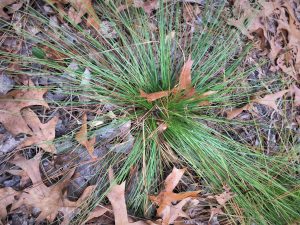
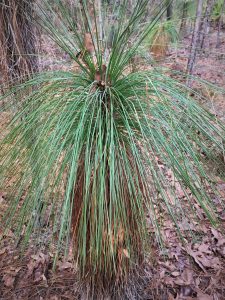
How can you beat the shaggy dog look during the initial height growth years!? I also like the often uneven-aged composition of natural and managed longleaf stands. The foreground sapling (lower left) stands back-dropped by a mature longleaf. One generation looking over the next. How many fires have passed through the stand since the older tree sprung from the grass stage? Without fire, the understory would have converted to other vegetation long before the sapling germinated, survived the grass stage, and began its height growth. Lower right shows another example of uneven-aged longleaf. The sapling stands at the base of a much larger and older individual; many mid-size longleaf occupy the immediate background. Every stand tells its own story of establishment and development. Such a stand offers rich diversity in crown height and canopy density, as well as ground-level sunlight and shade patterns. To upland birds, an uneven-aged longleaf forest offers a hearty welcome: Come one; Come all — There’s something for everybody!
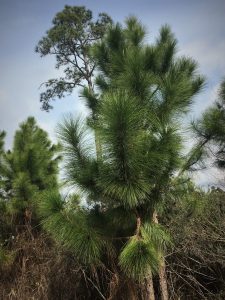
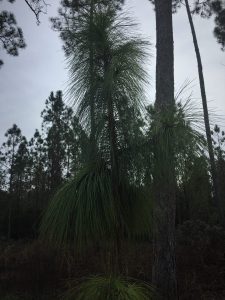
Slash pine (Pinus elliotti) throughout its range develops in even-aged stands. Its seedlings and saplings are far less tolerant of fire than longleaf. The open savanna (lower left) typifies a mature slash pine forest. The relatively flat canopies suggest that these pines have reached terminal height. Same for the individuals lower right — flat-crowns with coarse branching indicates maturity. Visualize botanist William Bartram traveling across the south on horseback through such forests more than 200 years ago.
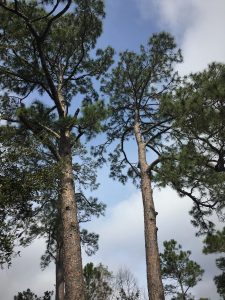
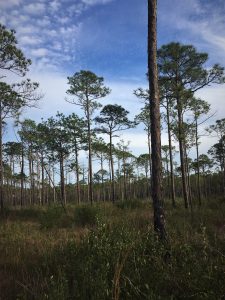
GSP’s evergreen forests do attract avian diversity, including the bald eagles who were tending young at this nest. One of these days I hope to acquire a real camera (graduating from my iPhone) with a lens capable of capturing more than a mass of branches assembled high above in a tree fork. Please apply your imagination and see the eagle with its white head emerging from the nest. We also saw another occupied eagle nest on the Park. What a great story nationwide of bringing this magnificent avian pinnacle-of-the-food chain back from the abyss to abundance. The message is clear — if we awaken with head, heart, and intent to save a specific charismatic mega-fauna, surely we can respond to save Homo sapiens from degrading our one Earth beyond a threshold of restoration, conservation, and management. The year of my birth, our global population stood at 2.5 billion; we are now at 7.7 billion. The eagle recovery offers hope and promise for our future as Earth citizens… but only if we awaken to our self-induced peril.
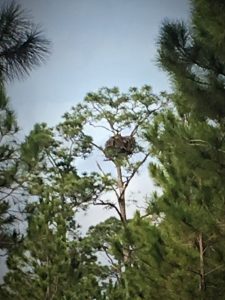
Only we can save us from ourselves; the burden is ours alone. Gulf State Park’s Enhancement Project offers a fresh and essential way to demonstrate best practices for outdoor recreation, education, and hospitable accommodations… an international benchmark for environmental and economic sustainability. Two active eagle nests evidence success… success that can be extended in philosophy, principle, and practice globally.
Role of Prescribed Fire
Restore, conserve, and manage we must. As Yoda, the Jedi Master and ultimate sage and life coach, observed, “Try not. Do. Or do not. There is no try.” We must not try to save Earth from our own devices; we must restore, conserve, and manage ourselves and our planet sustainably. Lessons from the Park Enhancement Project begin the journey of saving us from ourselves.
Employing tools like prescribed fire is one step in the journey… a journey that occurs one ecosystem at a time and culminates in our global ecosystem here on island Earth. Since the first time a lightning bolt seared tinder grassland or forest, ecosystems have evolved with the ravages and benefits of periodic fire. We employ prescribed (also termed controlled) fire to yield the benefits and avoid the ravages. To burn under our terms to achieve results of our choosing. Consider prescribed fire a tool that we apply judiciously, mimicking nature’s way to reach a desired future condition.
Nature’s seeks to convert GSP wetlands and meadows to forest, a “climax” ecotype that will persist until catastrophic wind or wildfire begins the cycle anew. Were the Park a “preservation,” standing back over the long course of time might be an appropriate option. One summer during my Alaska days, fire consumed six million acres of boreal forest and taiga, with little attempt at suppression and control beyond protecting villages and scattered cabins. Mostly federally-owned wildland, fire amounted to a natural occurrence allowed to run its course awaiting rain or the eventual snowfall. The same no-suppression practice prevailed a few years ago as wildfires raced across vast expanse of remote Yellowstone National Park. We cannot afford the luxury of “preservation” at GSP. We must focus aggressive on restore, conserve, and manage to meet desired outcomes.
Lower left shows a meadow intent upon converting to slash pine forest. Managers control burned the tree-colonizing meadow in November 2018, the 28th day of the month… just before the seasonal burn window was about to close. Crews wanted a burn intense enough to kill the encroaching pine. The two individual saplings may have escaped mortality (they retain tufts of green foliage at their tops); most of the seedling pines are dead. Again, slash generally does not handle fire well at the seedling stage. Managers can eliminate the few surviving trees if they wish. The fire at lower right sought a different result. Managers (that same November day) ran a less intense fire through this established sapling and pole slash pine stand to retard the thick brush and understory hardwood trees that were encroaching, competing effectively with the pine, and that would eventually convert this site (via natural succession) to other than evergreen forest. The Park land management plan designates a desired pattern of ecotypes. Fire helps achieve the targeted pattern.
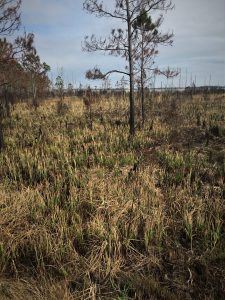
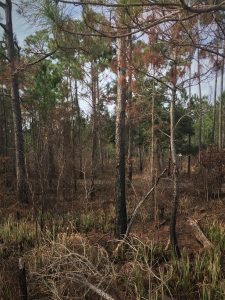
Lower left is another wet meadow burned to deny the invading slash pine army a permanent foothold –seeing the standing dead small saplings. Lower right demonstrates that once slash pine reaches that critical diameter of 3-4″ it can tolerate a fairly hot ground fire. This individual had a a little lower crown scorch and will thrive this coming growing season. Yet the fire burned or killed the visible above ground vegetation nearby, include the saw palmetto (Serenoa repens).
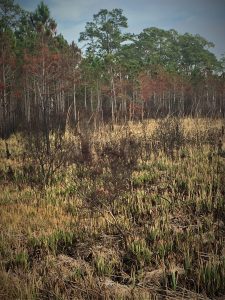
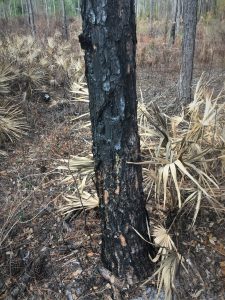
Here’s an unburned saw palmetto on the Park.
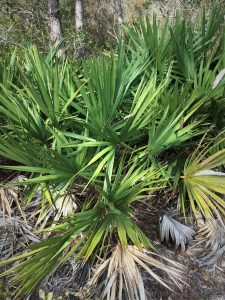
Xeric Forests
The Gulf of Mexico coastline has shifted over the long course of time. The Eastern Gulf Coastal Plain physiographic province covers nearly two-thirds of the state. The Lower Coastal Plain constitutes roughly the southernmost one-third of the state. As ocean levels have ebbed and flowed across the past few million years, the beach line from time to time extended inland to the Upper Coastal Plain. We should not be surprised that the entirety of GSP comprises multiple dune lines… upland areas of deep sandy soil. These dry (xeric) and infertile sites support forest types quite distinct from the evergreen forests. Sand live oak (), turkey oak (), and longleaf pine are the major overstory species. Tree heights seldom exceed 30-50 feet. Stocking (the number of stems per acre) is low, as is the biomass per acre. Dense overstory and deep shade are uncommon. The understory is relatively open, contrasted to the more common jungle-like subordinate vegetation in the evergreen forests. The lower left photo shows typical stocking, crown density, species composition, and understory condition. Lower right shows an old access road leading north along the now-abandoned Park golf course to a former cattle-dipping station.
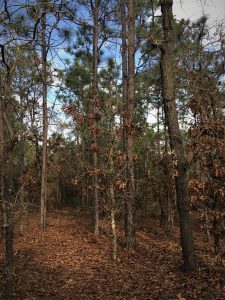
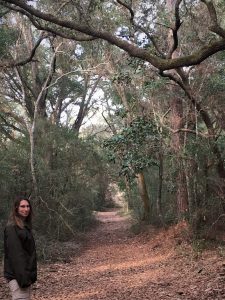
We found a few very impressive sabal palmetto (Sabal palmetto) on these old dune ridges. Attractive fanning foliage.
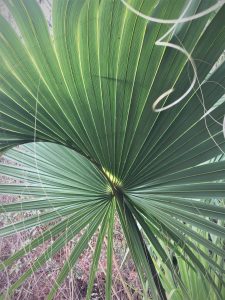
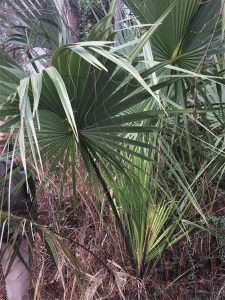
Sand live oak (Quercus geminata) seem content to occupy horizontal space rather than reaching for sunlight above. Joyce Kilmer would have delighted in this individual (lower left). No designer among our own species could create a finer specimen. Although I am not absolutely sure, I believe the species lower right is southern live oak (Quercus virginiana), the quintessential live oaks that line the streets of Savannah and Mobile, and that grace some of the Old South mansions of movie fame. Note the draping Spanish moss (Tillandsia usneoides). From the Florida Extension Service: “Hanging off trees and landscape plants, Spanish moss is a familiar part of Florida’s environment. Despite its name, Spanish moss is not a moss but a bromeliad—a perennial herb in the pineapple family. Most bromeliads, including Spanish moss, are epiphytes. Epiphytes grow on other plants, but do not rely on them for nutrients. They take nutrients from the air and debris that collects on the plant.”
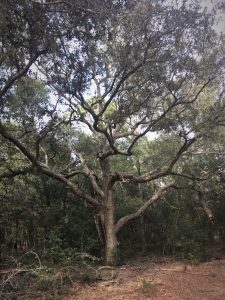
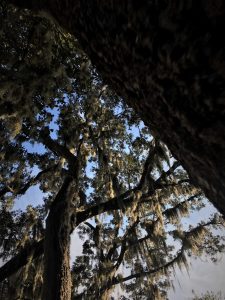
Did I mention that both sand and southern live oak are “nearly evergreen,” dropping its leaves and sprouting new foliage within several weeks in the spring. Here are sand live oak leaves, during my mid-January visit, still looking quite summer-like.
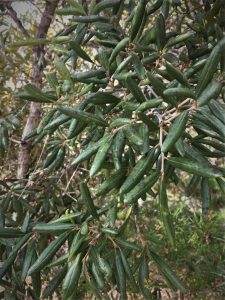
Turkey oak (Quercus laevis) tolerates the most xeric of the old dune ridges. Its corky bark (lower left) protects established individual stems from periodic fires. Few other hardwood trees can survive the dry, sandy soils of the old dunes. Longleaf pine often shard these inhospitable sites. Easy to see how this oak earned its moniker — its leaves (lower right) resemble a turkey’s foot.
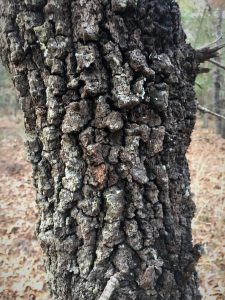
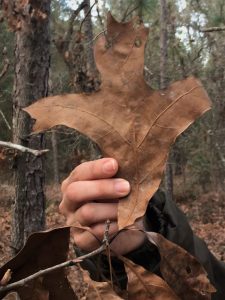
Lichen has colonized this turkey oak trunk. Recall that nature abhors a vacuum.
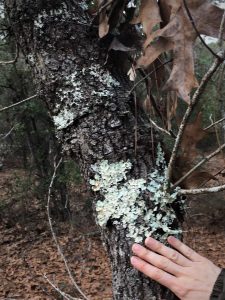
Lichens find purchase at ground level on these exeric sites. This species is deer moss (Cladonia evanesii), apparent in both small clumps and as a nearly full ground cover.
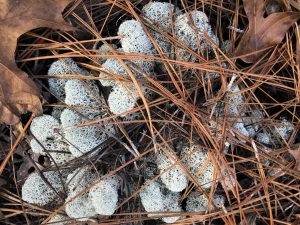
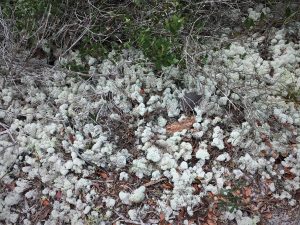
Dixie moss lichen (Cladonia subtenuis) is common yet less prolific at Gulf State Park. Note its greenish hue contrasted to the near white of deer lichen.
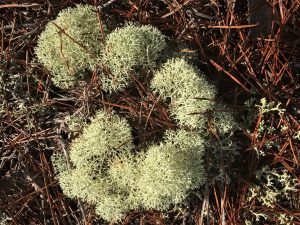
We saw occasional patches of prickly pear cactus (Opuntia sp.), a preferred food for the endangered gopher tortoise. The gopher tortoise digs borrows (lower right) in deep sandy soils across its range. I recall setting aside and protecting habitat and gopher tortoise communities on suitable sites within Union Camp Corporation’s woodlands in Alabama’s coastal plain. From the Florida Fish and Wildlife Conservation Commission: “Gopher tortoises are long-lived reptiles that occupy upland habitat throughout Florida including forests, pastures, and yards. They dig deep burrows for shelter and forage on low-growing plants. Gopher tortoises share these burrows with more than 350 other species, and are therefore referred to as a keystone species. ”
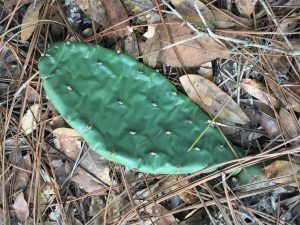
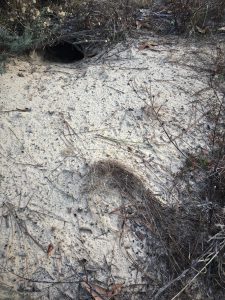
Park personnel are contemplating a significant habitat shift for the Park’s golf course, which abandoned golf operations in December 2018. Within the Park’s coastal legacy Enhancement planning, what is the highest and best use for the former golf course? Looks pretty good just sitting there with that luscious sky — that beautiful firmament showcasing above it! Perhaps managers will simply allow nature to implement her own plans… doing what come natural to her. Isn’t the golf course yet another vacuum? Another opportunity to creatively fill a void? I’ll look forward to seeing the plans unfold… whether Park staff designed or nature-designed.
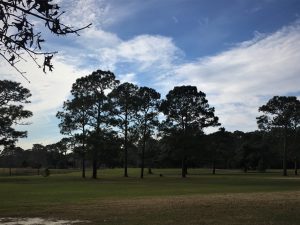
May Nature enrich your life and living… Nature-inspired living! And may you pass it forward.

Thoughts and Reflections
I wrote my books (Nature Based Leadership (2016) and Nature-Inspired Learning and Leading (2017)) and the two scheduled for 2019 (Weaned Seals and Snowy Summits: Stories of Passion for Place and Everyday Nature and Natural Elixir: Lifting Your Life through Nature’s Inspiration) to encourage all citizens to recognize and appreciate that every lesson for living, learning, serving, and leading is either written indelibly in or is powerfully inspired by Nature. Both published books are available on Amazon and other online sources.
Here are three succinct lessons I can easily draw from this Blog Post:
- Fire and forests seem strange bedfellows, yet some forests are absolutely fire-dependent; understanding Nature requires that we comprehend relationships.
- Everything in Nature and life functions according to resource availability and limitations.
- Nature’s beauty, magic, wonder, and awe pay little mind to site constraints and limitations — a majestic evergreen forest possesses no more nobility than a xeric scrub oak forest.
May Nature Inspire and Reward you!
Note: All blog post images created & photographed by Stephen B. Jones unless otherwise noted. Please circulate images with photo credit: “©2019 Steve Jones, Great Blue Heron LLC. All Rights Reserved.”
Another Note: If you came to this post via a Facebook posting or by an another route, please sign up now (no cost… no obligation) to receive my Blog Post email alerts: https://stevejonesgbh.com/contact/
And a Third: I am available for Nature-Inspired Speaking, Writing, and Consulting — contact me at steve.jones.0524@gmail.com
Reminder of my Personal and Professional Purpose, Passion, and Cause
If only more of us viewed our precious environment through my own filters. If only my mission and vision could be multiplied untold orders of magnitude:
Mission: Employ writing and speaking to educate, inspire, and enable readers and listeners to understand, appreciate, and enjoy Nature… and accept and practice Earth Stewardship.
Vision:
- People of all ages will pay greater attention to and engage more regularly with Nature… and will accept and practice informed and responsible Earth Stewardship.
- Great Blue Heron clients will see their relationship to our natural world with new eyes… and will understand more clearly their Earth home.
Tagline: Steve (Great Blue Heron) encourages and seeks a better tomorrow through Nature-Inspired Living!


